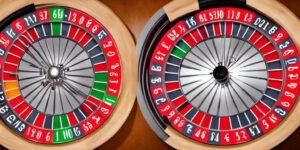Stepping into the world of a casino, the sight of the mesmerizing roulette wheel never fails to captivate me. The iconic red and black pockets, the enticing sound of the ball dancing around the wheel, it all adds to the allure of this classic game of chance.
The roulette wheel, with its rich history dating back to the 18th century, continues to be a symbol of elegance and thrill in casinos worldwide. Its simple yet elegant design holds the key to both heart-pounding wins and heart-wrenching losses. With each spin, the anticipation mounts, making every moment spent at the roulette table an exhilarating experience.
Types of Casino Roulette Wheels
American Roulette Wheels

American roulette wheels are characterized by 38 pockets, numbered from 1 to 36 with an additional 0 and 00 pockets colored in green. The presence of the double zero (00) pocket distinguishes American wheels from their European and French counterparts, impacting the game’s odds and increasing the house edge. Players betting on individual numbers face slightly lower winning probabilities due to the extra pockets, contributing to the wheel’s unique configuration in American casinos.
European Roulette Wheels
European roulette wheels feature 37 pockets, including numbers 1 to 36 and a single 0 pocket colored in green. Unlike American wheels, European variants do not include the double zero (00) pocket, offering better odds for players and reducing the house edge. The absence of the double zero pocket provides a more favorable playing environment for gamblers placing bets on specific numbers, contributing to the popularity of European roulette in casinos across the continent.
French Roulette Wheels

French roulette wheels closely resemble their European counterparts with 37 pockets, featuring numbers 1 to 36 and a single 0 pocket. However, what sets French wheels apart is the “La Partage” rule, which returns half of the even-money bets to players if the ball lands on zero. This feature further reduces the house edge, making French roulette an attractive choice for players seeking improved odds and a unique gaming experience. The combination of the traditional wheel design with the advantageous rule adds a distinct flavor to French roulette tables, appealing to enthusiasts looking for a competitive edge in their gameplay.
Components of a Casino Roulette Wheel
Examining the casino roulette wheel, I’ll delve into its fundamental components that contribute to the excitement and mechanics of the game.

- Pockets: The pockets on a standard roulette wheel are either red, black, or green, corresponding to the numbers on the wheel. These pockets are where the ball lands, determining the winning number.
- Numbers: A typical roulette wheel consists of numbers 1 through 36, alternating between red and black colors. The presence of the green pocket(s) with ‘0’ (and ’00’ in American roulette) gives the house its edge.
- Ball: The small, ivory ball is spun in the opposite direction of the wheel by the croupier. Its trajectory and momentum as it bounces around the wheel influence the outcome of each spin.
- Wheel Head: This is the top wooden part of the wheel where the ball initially makes contact before settling into a pocket. The wheel head’s design can vary, influencing how the ball moves as it spins.
- Wheel Track: The inner part of the wheel where the ball travels around before coming to rest in a pocket is known as the wheel track. It is designed to ensure unpredictability and fair gameplay.
- Rotor: The rotor is the spinning part of the wheel where the ball initially lands after being released by the croupier. Its speed and the ball’s movement on it are crucial in determining the result of a spin.
Understanding these components gives players insight into the mechanics of the casino roulette wheel, enhancing their appreciation of the game’s intricacies and adding to the thrill of each spin.



